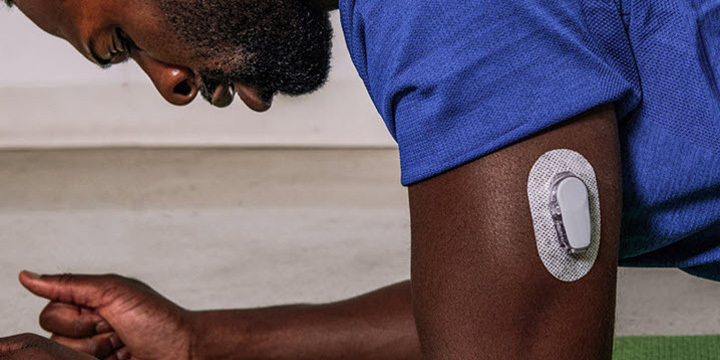
Continuous glucose monitoring systems have become more commonly used in recent years by Canadians living with diabetes. There are various systems available, which have many similarities, including:
1. A continuous glucose sensor can provide a new reading every 1-5 minutes (it varies by system).
2. An arrow is provided to indicate where glucose is going and how quickly the level is moving up or down.
3. The display will show how your glucose level has changed over the past few hours so you can look back and see the effect of different meal and activity choices on your glucose levels.
4. Some systems display messages that can help you decide if action is needed. For example, a Low Alert might warn you to consider consuming glucose to return to your target range. Some systems can even predict if glucose will be low in the next 20 minutes before a low glucose happens.
5. Glucose data is used to create simple reports to assess your glucose control, including:
- Time in range – the percentage of time you spend in, above or below your target range.
Reports that can help you and your health care team manage your diabetes more effectively. For example, the AGP (ambulatory glucose profile) report automatically converts glucose readings into a picture to easily identify times of day where glucose might be too high or too low. The information from an AGP report can help you have a discussion with your healthcare team about goals for your diabetes management and ways you can achieve them.
6. Glucose readings are stored securely in the cloud and/or on your smart phone so it is easy to review at any time or share with your healthcare team.
How are the systems different?
One important difference is how you receive the glucose information from the sensor. Real-time continuous glucose monitors (rtCGM) include a transmitter on the sensor, which automatically sends the most current results every 5 minutes to a display device, allowing the user to see the reading and direction of change arrow at a glance. A display device can be a compatible smart phone and smart watch, or a receiver made specifically for the system you are using. A manual scan is not needed to view or store data. Real-time CGM sensors can also display glucose data on some insulin pump screens and, with some insulin pumps, be a part of a system that triggers the pump to adjust the dose of insulin in response to the current or predicted glucose level.
Intermittently scanned continuous glucose monitors (isCGM), previously known as flash glucose monitors, require the user to scan the sensor with a smart phone or receiver to be able to see the glucose reading or trend arrow. If the sensor is not scanned, the information is not passed to the display device. The display device must be scanned every 8 hours to ensure data is not lost.
In summary, a rtCGM system (Dexcom or Medtronic) automatically collects and displays glucose data while the isCGM (FreeStyle Libre) system requires a manual scan to view and collect glucose data.
What should you know?
Another important difference is the types of alerts with each system. Real-time CGM systems can warn you of a high or low glucose level.
You can choose the glucose level at which you want the alert to happen and choose the type of sound for each alert. Some systems can predict when a low glucose is imminent. At a glance, you can see the current reading and an arrow showing where glucose is going. These alerts can help you know when to take action, before a low or high glucose event occurs.
There are two versions of the isCGM system in Canada. The original version (FreeStyle Libre 1) does not have alerts. The newer version (FreeStyle Libre 2) can detect if glucose is low or high, however, the user must scan the sensor to see the current glucose level and trend arrow. isCGM systems have less predictive ability as the value must reach a certain level for the alert to occur.
Some systems have an optional app that trusted family or friends can use to receive alerts that you choose to share. With the isCGM system, the user scans the sensor for a support person to see the information. With the rtCGM system, the alert appears automatically. Many parents of young children and often children of senior adults report this feature provides them with some peace of mind.
Which one is for me?
All systems provide excellent data on your glucose levels. How you receive the data (manually or automatically), the types of alerts you wish to receive (none, currently low or high, predicting low glucose) and the ability to integrate with an insulin pump, differ across systems. The scientific evidence for impact on A1C, time in range and time below range, also differs across systems. When making the decision about a CGM device, ask yourself what features are important to you and your diabetes management goals.




